#konishi yukinaga
Text
For most of his life, Yukinaga dreamed of travelling around the world. Living the way he pleased in a place where nobody knew him and tried to control his life. After Hideyoshi-sama banned Christianity, he just didn’t feel like he belonged anymore.
However, this time was different.
Stepping on the Japanese soil for the first time after years of living in a foreign land, he almost cried. He thought he would never return. Yet, there he was... Back to the place where he was born.
A small hand nervously clutched his own, the little girl probably felt the exact opposite to what he felt. (No) thanks to him, she was now a stranger in a foreign land. Yet, he couldn’t just leave her in a country that he and his fellow countrymen had burned to the ground with no one to take care of her. They had survived together against all odds by relying on each other. She was the reason he managed to stay sane after years living in a hell-hole he partly created.
He kneeled in front of her and stroke her hair gently and told her in her language,
“It’s alright... You are safe here...”
She nodded, implying she understood. He stroke her hair gently.
He stood up and led her to leave the harbor. That’s when he saw a face familiar to him waiting. The person to whom he owed his life...
“Mitsunari...”
--
@ishidasakichimitsunari
Aaa... this is my first rp. Hopefully, this is not the wrong way to do it.
521 notes
·
View notes
Photo

attempt at a more cartoonish style
Mitsunari and Yukinaga discussing strategies and Mitsunari forgetting his tea
8 notes
·
View notes
Text
Korea: The Imjin War

The Imjin wars are one of the really, really dark moments of the Sengoku Jidai and of Japan’s history. Not so much for what happened there, though that certainly contributes heavily, but for the precedent that it would set. The Imjin wars, or rather, Japan’s invasion of Korea, would use a route that would find itself repeated 300 years later. Japan would annexe Korea much more successfully and devastatingly in the 1900s and leave a mark on both countries that cannot be forgotten.
The post is under the cut, once again this is too long to just sit on the blog
This is why I think it’s important, outside of what I’m doing, to talk about the Imjin Wars. It gives you a taste, a small peek into what would happen later on. There’s no way of knowing whether or not – had HIdeyoushi’s attempts never come to any fruition or never dreamed up in the first place – the Imjin wars were the direct cause of this invasion. They probably weren’t but it feels as if there might have been some bitterness that caused such atrocities.
Enough about the 1900s, that will get its own, far more detailed post when the time comes. The invasion of Korea was staged after months of preparation. Daimyos led men to Kyushu where they would then sail across to the peninsula off the Asian main land. Daimyos such as Tokugawa Ieyasu “got out of it”, Tokugawa himself claimed the vast distance form his lands to Kyoto as a reason not to be involved. Others would march their men to Kyushu and commit atrocious acts that cannot be forgotten.
The playing countries would not just be Japan and Korea but also China – Hideyoushi’s intended destination by route of Korea. However, the Ryukyuan king was a vassal of both Ming China and the Toyotomi Taiko. Letters that Hideyoushi exchanged with him would go on to be sent to the Ming as well. This actually served to confuse the Ming as the letters addressed Hideyoushi’s demands that the neighbouring countries pledge to him. These countries included the Ryukyuan, the Philippines and Korea. They wondered why exactly the Koreans had never raised it with them
The fact of the matter was, the Koreans were actually trying to go through with Hideyoushi’s demand. They all knew that if a war erupted between Japan and China then it would be fought on the middle ground – Korea.
His demands would be a little lost in translation. The owners of the port, the Sou clan, understandably did not want a horde turning up on their door step to invade Korea – which was considerably closer to them than most others. They also didn’t want to hand over any power to smaller clans, they got away with more and there were families such as the Matsuura who were suspected of Piracy. If this turned out to be true then it would really undermine the strength of the Sou and they might just get the boot.
So, what did Sou Yoshishige do? He softened down Hideyoushi’s words a little, made them less demanding. Granted they were then sent with a Tachibana man who supposedly demanded to be treated as some sort of foreign King (that’s not exactly how it’s worded but, he wanted far too much). On top of this he also insulted the fact that Koreans were shorter than the Japanese, which I imagine didn’t go down too well. Understandably of course.
None of this would come to any fruition, even Sou’s “down toning” of HIdeyoushi’s demands wasn’t soft enough. The Koreans were outraged by his use of personal pronouns that were kept only for Emperors. On top of this, Hideyoushi referred to himself as the “King of Japan” which both implied he had murdered his predecessor (which if theories are to be believed, he might well have done) and that the Emperor was of no consequence. On return the ridiculous ambassador was executed and Yoshishige removed from his post.
Then, it got worse. Hideyoushi claimed that he had been conceived by some divine radiance and with this power intended to invade China. As the Koreans were already well aware, this meant he would go through their country. He essentially gave the Koreans two options – fight with him or be fought against.
They did arrange an audience with him but it was only stood after four months and Hideyoushi didn’t make things better. The Koreans weren’t give the banquet they’d been expecting – heck, by the sounds of it this was just common courtesy – but instead just a communal bowl of sake and rice cakes. On top of this, Hideyoushi was hardly dressed for the event as he wore typical, everyday clothes. To add even more insult to injury he was cradling the baby Hideyori who picked that perfect time to urinate on him. Things were going just swimmingly.
On top of this, Hideyoushi made an idiot of himself politically. By this I mean he appeared naïve and the Koreans were quite assured this potential lord was a complete buffoon. Hideyoushi was still bitter about the Mongol invasions of Japan, which, for a start, had failed and been staged around 250 years before he was born. He wanted to get revenge on China. The dynasty that had been the root of the invasions were the Yuan, the current Dynasty was the Ming and they had been for 200 years.
Without the potential allies of the Koreans, operations were set up in Kyushu. Seen as it was the closest to Korea, it only makes sense that 52% of the labour and general man power came from there. It was also a financial move as the cost of bringing things and men from Kyoto compared to staying in Kyushu would have been exponential. Eventually he’d gathered up 335,000 men to invade Korea, however, only 158,000 would go.
The three Generals who would lead the forces to land in Korea were all young and enthusiastic, without a doubt. They were: Kato Kiyomasa, an eccentric distant relation of Hideyoushi; Kuroda “Damian” Nagamasa, the son of Hideyoushi’s trusted strategist, Kuroda “Simeon” Yoshitaka whose name was also Kuroda Kanbei; and Konishi “Augustin” Yukinaga. Seen as Kato and Konishi are getting their own posts, I’ll talk about Damian.
He was born Kuroda Nagamasa in 1568, so was only 24 when sent to Korea. Still, he already had plenty of experience to boot, supposedly first taking up the sword at the age of nine – though, I would like it to be confirmed by someone who has better sources than me. I know they started young but not…that young. Either way, he would convert to Christianity along with his father but, unlike his father, wouldn’t renounce it when Hideyoushi got a bit antsy about it all.
Needless to say, there was tension between the two Christian generals and Kato. Kato Kiyomasa was a stanch and occasionally violent Buddhist belonging to the Nichiren sect. Something that he is quite infamous for is attacking and killing pregnant Christian women. He would then proceed to slit open their stomachs and behead the foetus. Awful, I know. It’s easy to see why he might not have gotten on very well with Damian and Konishi, I imagine they got on swell.
This was only the first invasion and they moved through Korean with efficient destruction with other, lower commanders. In the June and July 1592 a team of Magistrates were sent across to report on the situation, reaching Hanseong (Seoul) in the July. This team, so to speak, consisted of Mashita Nagamori, Otani Yoshitsugu and Ishida Mitsunari. They would send a letter back, condemning the campaign and how bad it was really going – especially now the Chinese were getting involved. They warned Hideyoushi that the Japanese would be eliminated if they didn’t pull back almost immediately.
The first campaign came to an end a year later, when the great admiral Yi Sun-shin (who Jonathan Clements says needs a book for himself and I agree) cut off the Japanese supply lines. On top of this, the Ming sent an impressive force under Li Rusong. At their wits end, Konishi and Kuroda retreated back to Seoul while Kato, the only one who had really had any success past Seoul, continued right on conquering until he realised he may well get the blame for their failings.
Li Rusong would stop chasing the Japanese back when they reached Seoul, he had no desire to fight them. There were 20,000 within the city and the two had much in common really. His troops were diseased – as was common when fighting in a foreign land, along with this – much like the Japanese forces – his supply lines were stretched and men who fought on empty stomachs were poor fighters.
Kato and Konishi would come to more disagreements when Konishi - having received an order from Hideyoushi to retreat to Busan – demanded peace terms. They were agreed, the Japanese would not be chased any further in their retreat, peace would come if they handed over their hostages. Two Korean Princes had fallen into the hands of Kato, who refused to give them back. It would be Konishi who would do the talking and promise their return. Not to say that Hideyoushi was going to be very happy about Konishi’s decision in his name either – Konishi agreed that HIdeyoushi would become a vassal of China and be known as the “King of Japan.”
The Japanese also, did not go peacefully. They would loot and rape as they pleased, taking women with them as they went south. On top of this they broke into, looted and burnt the corpse of a dead Korean king. They then replaced the body with that of a commoner, in the hopes that the Koreans would fall for the trick and venerate a simple man. It’s a cruel prank that’s a big deal, ancestors were and still are a part of Koreans’ lives.
In the June of 1593 Chinese envoys arrived in Kyushu and while we can laugh about the fact that Mitsunari was put in charge of entertainment (merely funny because of the supposed character the man had) it was a serious issue. Both sides had lied to one another, Hideyoushi had no idea that he was the “King of Japan” and a vassal of China. Supposedly, Hideyoushi was all but illiterate but I just don’t think I can believe this – he was the Taiko and had so much power, there’s just no way he was illiterate. What I think Clements is trying to say is that he didn’t know the Chinese script, which is understandable at least – the two are different and 1100 years of only minimal contact allowed the Japanese and Chinese scripts to evolve very differently though they remained similar.
Although Konishi had tipped off the city of Jinju of Kato’s impending invasion on order of Hideyoushi they either didn’t receive it at all or simply didn’t believe the tip off. They remained in their city and would be massacred. Although the first attempt to breech the walls would fail, the second allowed for a wall to collapse after heavy rain. Kato’s troops would pour into the city and kill every soul, leaving 60,000 dead, many of whom were women and children.
We do have a story from this, telling the story of a Giseang (vaguely akin to a Japanese Geisha; although the form of Geisha we know (think Memoirs of a Geisha, not very accurate but a good starting point) did not exist at the time) named Non Gae. She called a celebrating Samurai to her, embraced in a bear hug and leapt to her death in the river below, taking him with her.
When negotiations opened up again Konishi would once again take it upon himself to dismantle Hideyoushi’s demand, reducing their severity and making him sound a lot humbler – such as a good little vassal should be. Hideyoushi had no idea of this. The Koreans however, knew exactly what was going on and were already preparing for the next attack for when Hideyoushi found out the truth.
It would be in October 1596 when Hideyoushi, now 60 years old with failing eyesight and a poor appetite, would find out the truth. When he had two scrolls translated he discovered he was being called “King of Japan” along with a mildly threatening warning that if he or his descendants ever sent trading ships to China they would be sunk on suspicion of being pirate vessels.
Hideyoushi would fly into a rage, tearing off the crown and robes he’d been given by the envoys.
“[He] flew into such a Passion and a Rage that he was perfectly out of himself. He froth’d and foam’d at the mouth, he ranted and tore till his head smoak’d like fire, and his Body was all over in a dropping sweat” – Rodrigues the Interpreter
A second invasion would be launched in 1597. Hideyoushi, irate at the Koreans’ deception was focused solely on them – he no longer cared for China. He’d also ordered that Konishi commit Seppuku for his misdeeds and I, for the life of me, cannot work out or find out how he got out of that. If anyone knows I’d like a heads up.
During this time Mitsunari, sent over to oversee the forces once again, would write a letter back to Hideyoushi on the efforts…as in, well, how awful they were doing. That letter is actually rather famous. It’s considered one of the factors in the Western army’s loss at Sekigahara because Mitsunari decided that slagging off Kobayakawa was a good idea. I’m kidding, that’s a little critical of me and I actually believe he was right to do it. Although he earned himself the ire of Kuroda Yoshitaka and Kobayakawa Hideaki, which was a really bad idea in the long run, he was only telling the truth to the ailing (and almost dead) Hideyoushi.
In the September of 1598 the men would be recalled from Korea, Hideyoushi having died earlier that month. With upwards of 1 million people dead, largely on the Korean side rather than the Chinese or Japanese side, it was the bloodiest conflict of the era. With Toyotomi Hideyoushi now dead and buried it was only a matter of time before the tensions that had already been growing on home and foreign soil erupted once again into full scale civil war.
#Toyotomi HIdeoyush#Konishi Yukinaga#Kato Kiyomasa#So Yorishige#Admiral Yi Sun Shin#Yi Sun Sin#Li Rusong#Ming China#Imjin Wars#Joseon#Korea#Korean History#chinese history#Japanese History#Kuroda Nagamasa#Kuroda Kanbei#Kobayakawa Hideaki#Ishida Mitsunari#21 Days of Sekigahara
12 notes
·
View notes
Text
Konishi Yukinaga
For some time I’ve been interested in Konishi Yukinaga and collecting information about him. And this is the result.✩ It’s long and kind of a mess. I didn’t really touch individual battles in Korea, because the material is readily available anyway and I have very limited knowledge of Imjin war.
I knew almost nothing about him before I started, so some things were surprising, some not. It’s actually really hard to grasp what kind of person Yukinaga was. I know that the West seems to have this “the nicest guy around” image, but that isn’t really my impression.
FAMILY
Konishi Yukinaga was born in 1558✶1 as a second son of a Sakai’s Christian merchant and drug seller Konishi Ryūsa. It is said he was born in Kyoto and was taught Christianity from early years in a church. (Luis Frois) There’s a possibility he was baptized at birth.
His mother’s name was Wakusa/Magdalena. Magdalena is said to serve as a maid to Toyotomi Hideyoshi’s wife Nene in Osaka castle.
His wife’s name was Kiku-hime, who was also an enthusiastic Christian known as Justa. Nothing is known about her, though. (comes from Ukita clan’s records)
Now, Yukinaga also had a concubine 立野殿 (Tatsuno-dono???), who was also a Christian called Katarina. And they did have a child or two together. However, she later became a wife of Shimazu Tadakiyo. After Tadakiyo died, she was banished to Tanegashima as a Christian. (comes from Shimazu clan’s record, where the wife of Tadakiyo is written as former Yukinaga’s wife)
He had several children, but I’ll mention only two.
His daughter Maria married Sō Yoshitoshi in 1590, but he divorced her after Yukinaga was beheaded after Sekigahara. Maria and her son, later known as Konishi Mansho (1600-1644), were banished to Kyūshū (and his father never acknowledged him). In 1614 he was exiled to Macao, after that he visited Africa, Rome, entered the Society of Jesus. He returned to Japan in 1632 and started missionary activities. He was later captured, executed and martyred. He was the last officially ordained Japanese priest on Japanese grounds until Meiji period.
After the battle of Sekigahara, Mōri Terumoto executed his eldest son, he had promised to keep safe, and sent his head to Ieyasu. When Ieyasu saw it, he got angry, because he didn’t plan to kill Yukinaga’s son, because he was not guilty of anything, but the messenger told Ieyasu that the son committed suicide (he didn’t). He’s said to be 12 years old at that time. There was absolutely no reason for the son to be executed. Mitsunari’s children were all left alone.
He adopted a Korean girl and raised her as her own (or his wife did). In Japan she was given the name Otaa. Her Christian name was Julia. After the battle of Sekigahara, Konishi clan was destroyed, she caught Ieyasu’s eye and served him in Sunpu, receiving his affections. But because she refused to give up her faith and refused to become Ieyasu’s concubine, she was exiled from Sunpu in 1612. She kept her faith and was helping sick and abandoned.
During his whole life Yukinaga was donating to churches, building orphanages and hospitals, especially in Ōsaka and Sakai. Together with his father he built a hospital for people who suffered from the Hansen disease (leprosy) where they could be sheltered and taken care of.
LIFE
Yukinaga was adopted into a merchant family (father’s name 魚屋九郎右衛門) in Okayama. (in 1572 ???)✶2
He got noticed by a current lord of Okayama, Ukita Naoie, (when visiting him for business) and started to serve him. During peace negotiation with Nobunaga, Naoie sent Yukinaga to Hideyoshi, who took liking to him and made him his retainer. But because of his service in Ukita clan, he’s said to be close to Hideie.
We know for sure that in 1581 he served Hideyoshi who mentions him in a letter. So it was around this time when Yukinaga and his father Ryūsa✶3 started to serve Hideyoshi. This was at the end of Nobunaga’s invasion to Chūgoku. Yukinaga was involved with Kuroda Kanbee.
In 1582 he was made to supervise Shōdoshima (an island in Setōuchi) and by 1585 he was an owner and managed the harbour connecting the ships to Sakai and was also involved in development of rice fields. He was also collecting materials to build a church in a harbour. (Luis Frois)
It is said he was baptized in 1583, but considering he was born into a Christian family it’s speculated it was sooner or at birth.
In 1585 he participated in Kishū campaign and Shikoku campaign.
Around this time, his father Ryūsa became a magistrate of Sakai. His coworker was Sakichi-dono. Frois was such a good guy to tell us all about them: “Ryūsa was the best, ideal person, the first Christian in the capital and friend of all Christians and a father of the navy captain Yukinaga. His coworker was Sakichi-dono, Kampaku-dono’s vassal, big enemy of Ryūsa, who didn’t take any pleasure from Kampaku’s tyranny, and enemy of Christians. He was jealous, ambitious, arrogant and overall just corrupt.” (side note: Mitsunari did repress Christians on Hideyoshi’s orders, and there was an incident in 1586 he was involved in, which is around the time Frois wrote about him)
Yukinaga’s mother might have become Nene’s maid around this time, too.
In 1586 he was transporting weapons and food via Setōuchi. And he also dispatched a war ship for the attack on Shimazu.
In April 1587 Yukinaga met with Frois and Gaspar Coelho.
During the attack on Shimazu he was in charge of navy.
He was also acting as an agent between Hideyoshi and Sō clan of Tsushima, who were leading negotiations with Korea to let Hideyoshi pass through their territory to China (later, in 1590, Yukinaga’s daughter Maria became a wife of Sō Yoshitoshi - she might be married to him as a hostage and/or on Hideyoshi’s orders - according to Frois. A year into the marriage Yoshitoshi was baptized. Yoshitoshi fought for Western army, but because Ieyasu wanted to restore diplomatic relations with Korea after Sekigahara, he was forgiven and became the first lord of Tsushima-han. Because of this (?) after Yukinaga was beheaded at Rokujōgawara, he divorced Maria. He worked with Yukinaga on establishing peace with Korea during the Imjin war and continued with peace negotiation after the withdrawal. According to Kang Hang it was Yoshitoshi’s schemes that started the war, just a point of interest - Yoshitoshi was the main guy who communicated with Korea trying to make them let Japanese pass to China several years before the invasion).
Until 1587 he was using the name/pseudonym Yakurō (弥九郎), from 1586 he was called by his title Settsu no kami.
In June 1587 Hideyoshi forbids Christianity in Hakata and orders all missionaries to leave Japan in 20 days. Takayama Ukon gave up his property and rank and shocked everyone. It is said that Yukinaga was hiding Takayama Ukon and Organtino at Shōdoshima for a while. The reason Yukinaga wasn’t treated the same way was because he was useful for his merchant and Europeans connections, naval skills, and dealings with Korea. Hideyoshi most likely knew that he was hiding Ukon, but looked away anyway.
May 15 1588, after Hideyoshi dealt with Sasa Narimasa, Yukinaga was given the south part of the Higo province. The northern one went to Katō Kiyomasa and together they were supposed to rule over the whole province and consult with each other. The reason why Yukinaga got this province might be because it would serve as a base for marine transportation and he was best with navy. And it was also a good starting point to go to Korea.
In 1589, there was a riot on Amakusa. The local influential lords would only listen to Hideyoshi, not to Yukinaga. Yukinaga demanded that they restore Uto castle, but they refused. Yukinaga got a permission from Hideyoshi to pacify them and Katō Kiyomasa came with reinforcements. The riot was suppressed with their combined forces.
There are different stories. 1. Yukinaga asked for Kiyomasa to come 2. Hideyoshi said that they should not leave Higo both at the same time, so Yukinaga said to Kiyomasa to not come, so he would stay in Higo. But Kiyomasa came anyway and there appears to be a letter that says that Kiyomasa came on his own written by Yukinaga to Hideyoshi in some collections of letters.
During the attack on Hondo castle (where several Christians resided; Amakusa was a very Christian region), that Yukinaga had surrounded and the fall was only a question of time, Kiyomasa attacked quite brutally and killed everyone including women. This seems to be the start of their antagonistic relationship and then it got worse in Korea.
(When it comes to siege of Hondo castle, three hundred women were protecting it and all of them but two were killed by Kiyomasa’s forces.)
Yukinaga still served as a line to negotiations with Korea (i.e. Yoshitoshi was going through him to get to Hideyoshi).
In December 1589, there was a misunderstanding (caused by Asano Nagamasa??? misunderstanding a letter from Yukinaga???) that Korean king would visit Hideyoshi in Japan. Hideyoshi was expressing his joy in the letter to Sō Yoshitoshi (who was probably all wtf I’m gonna get killed, he was in Seoul at that time). Before the misunderstanding, Yukinaga with Shimai Sōshitsu (a merchant and tea master from Hakata) were supposed to visit Hideyoshi to talk about the visit from Korea??? (Yukinaga wrote to Nagamasa), but Yukinaga was unexpectedly caught up with the Amakusa riots, so he didn’t manage to come. After that Hideyoshi attacked Odawara and Yukinaga didn’t manage to clear the misunderstanding still being in Higo. Because the misunderstanding was big (a king wouldn’t be coming, just an envoy expressing congratulations), it was probably needed to clear it in person and not by letter or a messenger. (During this time, Yukinaga married his daughter to Yoshitoshi... i.e. it appears he made a secret alliance with Yoshitoshi and Sōshitsu to not tell anything, but wrote an explanation to the magistrates? anyway. Frois says that Yukinaga hated that he had to marry his daughter to Tsushima’s lord and that it was on Hideyoshi’s orders, but Frois didn’t know all circumstances. Probably. And Yukinaga is always made better by Jesuits. Yoshitoshi and Yukinaga seemed to work pretty closely and Yoshitoshi converted, so I don’t think Yukinaga was against it. This whole paragraph is from some article, so take it with a grain of salt; the letter background is correct, though, the rest could be the author’s interpretation and the actual historian’s version might be different. But it sounded quite legit. The author, however seemed to have a previous bias of “two-faced” Yukinaga, which seems to be his image, so it could be written to fit that image.) However, two days before the fall of Odawara, when Hideyoshi was in a good mood, someone (most likely someone from the magistrates who knew) told him the true (Hideyoshi wrote to Yoshitoshi again). But when the envoy came, he didn’t meet with them for two months.
Around this period (from 1588?? earlier), Yukinaga seemed to communicate with Hideyoshi through Asano Nagamasa (Murdoch says that he was his intimate friend and very influential person at Hideyoshi’s court, this was in 88, but I couldn’t find any Japanese source that they would be friends, according to (some) Jesuits during Sekigahara, they didn’t get along at that time).
In 1592, Yukinaga led the first division to Korea. While trying to demand clear path to China from Koreans, which were ignored, his army fought pretty brutally. They brought many victories, but soon the army became exhausted. (Apparently until the early Edo period, the evaluation of Yukinaga was pretty high as a commander, but after that the emphasize on Kiyomasa got stronger and Yukinaga took a back seat - probably because he was a Christian and was one of the “ringleaders” at Sekigahara; him being Christian is probably also a reason why there are less Edo created stories about him in relation to Sekigahara)
Yukinaga led the first division, Kiyomasa the second and they were trying to outdone each other who enters Seoul first. Yukinaga won.
During the capture of Pyongyang, Yukinaga again asked to be granted a free path to China:
"If you will send this army back to Japan we can confer about the matter, but we will listen to nothing so long as you are on Korean soil." Konishi continued: "We have no wish to harm you. We have wished such a conference as this before, but have not had such an opportunity until today." "Turn about and take your troops back to Japan," repeated the Korean. Konishi lost his temper at this, and cried out: "Our soldiers always go forward, and know nothing about going backwards." (Murdoch, p.331)
In the second half of 1592, Ishida Mitsunari with Mashita Nagamori and Ōtani Yoshitsugu described the current situation on the battlefield which saw the Japanese side losing with provisions and weapons lacking. At the beginning of 1593, both sides entered stalemate and after that Yukinaga, with Mitsunari and others began to seriously go for peace negotiations.
In May, Yukinaga with Mitsunari, Nagamori and Yoshitsugu returned to Japan with imperial envoy. They met Hideyoshi, who offered them a list of seven conditions. One of them was a marriage between Chinese and Japanese imperial family.
Yukinaga’s father Ryūsa seemed to be in charge of logistics on Japanese side, but he got sick in Hizen’s Nagoya and in 1592 died in Kyoto.
In 1595 a petition asking to bestow a title of a king to Hideyoshi included in a fake surrender conditions was sent to China. What’s interesting about this are the signatures:
Konishi Yukinaga, Ishida Mitsunari, Mashita Nagamori, Ōtani Yoshitsugu and Ukita Hideie are asking as a wide governor-generals/commanders in chiefs.
Tokugawa Ieyasu, Maeda Toshiie, Mōri Terumoto, Uesugi Kagekatsu, Kobayakawa Takakage, Maeda Gen’i, Natsuka Masaie, Sō Yoshitoshi, Ishida Masazumi, Konishi Suekito, Yanagawa Shigenobu are asking as sub-governor-generals.
This is estimated to be a plan with Yukinaga and Mitsunari in the center and it can be seen as one of the factor for Yukinaga joining the Western army - not only was he on good terms with Mitsunari, but he also had strong ties to the magistrates who helped him carry out the peace negotiations.
So the final result of that was a Chinese convoy that met with Hideyoshi offering him a position of King of Japan. And because the interpreter started to read even the surrender conditions, Hideyoshi got angry and ordered Yukinaga to be executed, but he was talked out of it (by a monk Saishō Jōtai, Maeda Toshiie ?). In Murdoch (that goes mostly by Jesuits accounts) it also states that Yukinaga had not much trouble to convince Hideyoshi that Mitsunari, Yoshitsugu and Nagamori were equally to blame as him (and I guess executing half of your administrative force wouldn’t be a good thing).
Yukinaga can be considered a good diplomat, but he was not above lying - to the enemies or to his own side (there are also instances where he lied to the missionaries in his letters, too). To his enemies he claimed that the Emperor and the ruler of the land are the same person, i.e. Hideyoshi.
In 1597 a new wave started. This time Yukinaga was ordered as a vanguard together with Kiyomasa.
In August 1598 Hideyoshi died and the troops were ordered to return back by the Council. Yukinaga was one of the last ones to return, still hoping to achieve a peace treaty before the withdrawal (it seems trade was especially important to him). On the way home the Korean ships were blocking his way, but with Shimazu Yoshihiro’s help, he managed to safely return home at the end of December.
Kang Hang has a bit to say about this. Because Kiyomasa arrived earlier, he was laughing at Yukinaga's cowardice.
“Kiyomasa did not hold on to the royal princes of whom he had taken as prisoners of war, burned his camp, and hurriedly left Chōson. He destroyed the opportunity for peace negotiations just when it was at hand. Shimazu and I led the Chinese hostages and, calmly serving as a rear guard, returned to Japan after everyone else. Did I exhibit cowardice, or did Kiyomasa exhibit cowardice?” Terumoto and the others blamed Kiyomasa for the failure to begin peace negotiations. Kiyomasa, as expected, of course blamed Yukinaga, saying that Yukinaga was of two minds regarding negotiations with our country. The discussion grew ever more entangled, and the enmity grew deeper and deeper.” (p. 87-88)
After the return from Korea, the dispute between two factions appeared. On one side, Konishi Yukinaga and his Christian daimyō friends that were fighting together with his division - Arima Harunobu, Ōmura Yoshiaki - Shimazu Yoshihiro, Tachibana Muneshige, Kobayakawa Hidekane (also Christian) centered around Ishida Mitsunari. This faction was for a complete withdrawal from Korea. In the other faction there were Katō Kiyomasa, Kuroda Nagamasa centered around Asano Nagamasa, who were still for continuation.
The dispute grew, others joined, and ended with the attack on Mitsunari later (and that the starting point could be an argument between Yukinaga and Kiyomasa makes much more sense than Kiyomasa getting angry that Mitsunari offered him tea after his return from Korea). [This comes from Jesuit reports, but since something similar is also mention by Kang Hang, I guess something happened.]
In January, Mitsunari publicly condemned Ieyasu and all other tairō, bugyō (including Asano Nagamasa) sided with him (so officially it was Council vs Ieyasu. The rest depends on how a person interprets it). Ieyasu talked himself out of it (it seems that forces on both sides were prepared to clash, but they made up before it could escalate).
Now, there is also a version where various daimyō would split between Maeda Toshiie’s residence and Ieyasu’s residence, because it was Toshiie who condemned Ieyasu. (with some theories that there were 3 factions, and Mitsunari just joined in with Toshiie)
Tokugawa side: Fukushima Masanori, Kuroda Yoshitaka (Kanbei) and Nagamasa, Ikeda Terumasa, Tōdō Takatora, Kyōgoku Takatsugu, Date Masamune, Mogami Yoshiaki, Mori Tadamasa, Wakizaka Yasuharu, Ōtani Yoshitsugu etc.
Maeda side: the rest of Elders - Uesugi Kagekatsu, Ukita Hideie, Mōri Terumoto; magistrates: Asano Nagamasa, Maeda Gen’i, Ishida Mitsunari, Mashita Nagamori, Natsuka Masaie, Katō Kiyomasa, Konishi Yukinaga, Asano Yukinaga, Hosokawa Tadaoki, Katō Yoshiaki, Tachinaga Muneshige, Oda Hidenobu, Chōsokabe Morichika etc.
While this list was made up later, it’s probably more or less correct, but the actual situation could have been different (fun fact: Kang Hang also mentions this event and Masamune and Mogami Yoshiaki are on Toshiie’s side).
Around this time Yukinaga is invited to a tea ceremony organized by Mitsunari. Other guests are Ukita Hideie, Date Masamune and Kamiya Sōtan. After they finished enjoying the tea and talking, Mitsunari also gives his guests wine originated in Nagasaki. Wine was a totally expensive indulgent at that time. (This is from Kamiya Sōtan’s diary, a merchant and tea master from Hakata. Some people consider the diary a fabrication, because of inconsistencies in few dates, but the description of tea utensils and tea ceremony is legit...) If Masamune and Mitsunari in one room seem weird, well... (but remember Kang Hang :D) Mitsunari probably wanted to persuade him to join him. (and their relationship wasn’t exactly hateful anyway, the one Masamune couldn’t get along with was Asano Nagamasa, from the bugyō)
Then Toshiie died and Mitsunari got attacked by Kiyomasa and his friends. With the help of Satake Yoshinobu (at least that’s the common view), Mitsunari managed to escape from Ōsaka to Fushimi. According to Jesuits, Yukinaga took arms to help him and followed him to Fushimi. Mitsunari wanted to counterattack more heavily and asked Terumoto for reinforcements by sending Yukinaga to Terumoto, but Ōtani told him not to send them (because the situation was unfavourable).
Ieyasu intervened (either by himself, or someone went to him, or he just tried to pacify Kiyomasa’s group who demanded that Mitsunari was dealt with) and Mitsunari lost his job and was sent to Sawayama. According to Murdoch some missionaries wrote that Yukinaga either accompanied him (I doubt that) or visited him soon after (why not). When he visited him, Mitsunari managed to talk him into joining his little alliance (him + Uesugi Kagekatsu + Terumoto + Ukita Hideie). I don’t think Yukinaga needed to be talked (or induced) into anything (some Jesuits (or maybe Franciscans? They apparently blamed Jesuits for not telling Yukinaga to side with Ieyasu or for actually telling him to go against Ieyasu, but nothing like that can be confirmed from Jesuits reports... I read) also apparently expressed their dissatisfaction with Yukinaga joining Mitsunari. Other Jesuit, you can’t believe Jesuits when it comes to Yukinaga, it’s contradictory lmao say that Yukinaga was with Mitsunari from the beginning because they were BFFs, and because Yukinaga was loyal to Hideyori and they created this amazing alliance. Some recent researchers are also adopting the view of Yukinaga being a part of planning from early on). As for the alliance, there might have been one. It might just be a reference to the Council vs Ieyasu, or it could be all just rumours based on everyone returning home, followed by rumours of Ieyasu’s assassination (fun fact: Kang Hang says that Kiyomasa wanted to kill Ieyasu too). Mitsunari could have been behind all of them or not. But one thing that’s interesting is that if there was an alliance between Mitsunari and Uesugi prior to Sekigahara (historians are still debating, pro-Tokugawa are usually like nope and pro-Mitsunari are yeah, because they want Naoe-Mitsunari friendship to be true... that’s the image I’m getting anyway) it started before he got fired. That’s the common point of Kang Hang and Jesuits, but other Jesuits and Kang Hang also have Maeda Toshinaga in the alliance. This got confusing, sorry.
So Mitsunari got fired, and Ieyasu started to make friends with Yukinaga trying to get him on his side. He was apparently praising his achievements in Korea and his loyalty to Mitsunari. (He might have also offered his granddaughter to Yukinaga’s son - the one that Terumoto killed.) He basically wanted Yukinaga to pledge himself to his cause (he wanted this from most daimyō), but Yukinaga refused. Out of his friendship for Mitsunari, out of his loyalty to Hideyori, out of his dislike for Kiyomasa, out of his relationship with Ukita Hideie, out of his political view whatever suits your boat. We will never know anyway.
And then he returned to Higo and when an internal strife occurred in Shimazu clan (1599), he was dispatched there by Ieyasu together with other Kyūshū daimyō (e.g. Tachibana Muneshige and many more). Some people see this as him becoming closer to Ieyasu and then they’re all wtf why did he join Mitsunari, but I mean... he’s right there on Kyūshū, of course he’s gonna be asked to help (like Mitsunari dispatched forces during Ieyasu x Maeda Toshinaga conflict).
In June 1600, Ieyasu started the subjugation of Uesugi. Yukinaga was ordered by Ieyasu to stay in Osaka(-Kyoto).
At the beginning of July, Mitsunari and Yoshitsugu rebelled (around 11th or 12th of July). By 15th July, thanks to Shimazu Yoshihiro’s letter to Kagekatsu, we know that Yukinaga was a part of the whole anti-Ieyasu coalition. July 17, Ieyasu was impeached.
Yukinaga participated in the siege of Fushimi castle, then entered Ōgaki castle in early August, and in the evening of September 14, he moved to Sekigahara.
In the morning of the 15th he engaged in battle and thanks to Kobayakawa Hideaki’s betrayal, he was defeated and escaped to the surroundings of Mt. Ibuki.
Right on the 15th, Ieyasu ordered his men to capture him, Mitsunari, Hideie and Yoshihiro.
The most famous story you can find around: he was found on the 19th. Instead of running, he went forward and gave his name: “I’m Konishi Settsu no kami. Take me to Naifu and receive a reward.” The guy who found him told him to run, but Yukinaga said that because he was Christian, he couldn’t commit suicide. The guy took him to Takenaka Shigekado and got some money.
He was paraded around Ōsaka together with Mitsunari and Ankokuji Ekei being pronounced a rebel. After that they were moved to Kyōto.
On the 1st October, the three of them were executed in Kyōto. Because he was a Christian, he refused buddhist monks to cleans him and chant sutra for his sake, instead he took out a small picture of Christ and Maria and prayed. Then he got beheaded. His head (with Mitsunari and Ekei’s ones) was displayed on the Sanjō bridge. Before his death, he asked for a priest, but he was denied by Ieyasu. According to Jesuits records, his body was taken by the church and given a proper burial. The place is unknown.
In 1607 in Genova (Italy), an opera (?) was created with Yukinaga as the main character.
✶1 The year is based on a Korean document that states he was 38 in 1595.
✶2 comes from a source from 17th century, so he might never have been given out for adoption, but it’s used as his background often.
✶3 this basically makes the whole adoption thing weird, imo
✩ Yukinaga was beheaded as one of the key figures after Sekigahara and he was a Christian, so there are not many documents left. There are Jesuits notes, but those are heavily biased in favour of Christians, there are some mentions of him in the writings of Kang Hang, but those are understandably biased as well, even though he does not really paint him necessarily in a negative light, but as someone who wants peace to save Sō Yoshitoshi’s face. But it does come off as negative. For the Korean campaign, I just used Turnbull’s The Samurai Invasion of Korea 1592–98 and some stuff from Murdoch’s A History of Japan. The rest comes from various articles I read on the world wide web and some of it was “consulted” with wikipedia.
If anyone actually read the whole thing, I’m impressed. Thank you!
#konishi yukinaga#japanese history#samurai warriors#because i think yukinaga would be a nice add#but it could also end up horribly wrong#because koei can't write rivals without them also being friendly to some degree#and they would probably ignore his friendship with mitsunari#or it would be really really light like the one with nobuyuki#and they would put kiyomasa at sekigahara again#and most likely making him kill yukinaga because koei won't show mitsunari and him getting beheaded#and they will just turn into new takatora and yoshitsugu
17 notes
·
View notes
Text
Detective with a dark secret AU
Years ago, Patriarch Toyotomi Hideyoshi sent one of his protégés, a bright young man named Konishi Yukinaga, to infiltrate the Osaka police department.
Hideyoshi had no biological son, despite his excessive womanizing. So he took in orphans he saw promise in. Some, like Kiyomasa and Masanori, became his muscle. They were loyal, strong and not very smart. But they served their purpose perfectly. Others, like Mitsunari and Yoshitsugu, were better suited for administrative work, and they handled the clan’s finances and diplomacy. Hideyoshi loved them all as his own, even if they clashes with each other sometimes.
He gave the most difficult task to Yukinaga. To become his spy in the police force. The man was special. He had the acting skills and nerves of steel required for the job, he was top of his class at the police academy, and he turned out to be a very talented detective. He was only 35 when he became leader of the Organized Crime department, after solving many difficult cases. He was, in everyone’s eyes, the perfect policeman, professional, above corruption (he cracked down on any other informants to keep them from finding out his secrets). The very embodiment of the law.
But that was only the surface. In addition to being Hideyoshi’s spy, he was the Toyotomi Clan’s best assassin. No one would have suspected him. He worked in the shadows when his patriarch needed someone eliminated. A perfect weapon who never left any incriminating evidence. He was the one investigating most cases, including his own. The murders were sometimes pinned on enemy clan members, and sometimes written off as suicides.
Hideyoshi didn’t ask him to kill too often. Only when it was someone his brutes couldn’t handle, or a case that requires extra care.
Tonight, the patriarch had notified him he had a job for him, and to come in secret.
They had their meeting places. The clan practically owned the city. They had many secret hideouts perfect for clandestine meetings.
Hideyohi had only brought a few of his men, including his personal secretary, Mitsunari. They were waiting in a hidden tea house behind a seemingly abandoned old building.
It was late October, pouring rain, and past midnight. Not many would be in the streets.
Mitsunari had not seen Yukinaga in a while. They used to be good friends growing up, but Yukinaga was older and left the nest to go to the police academy. Since then, he had only seen him occasionally - apart from the news.
Now he was waiting for him to guide him to Hideyoshi.
@konishi-yakuro
1K notes
·
View notes
Photo


Hana Kurusu (lit. Flower Cross) clan crest was first used in the Battle of Sekigahara, Sengoku period. It's the family crest of the Konishi family. Konishi Yukinaga was a daimyo who used it.
Konishi Yukinaga was a devout Christian hence the cross symbol (kurusu). Unfortunately for him, he was defeated in the said battle. He fled to the mountains but was captured. As a Christian, he refused to perform seppuku and was beheaded by his enemy.
Ura Ume (lit. Reversed Plum blossom) clan crest is associated with the man who deeply loved it, Sugawara no Michizane, Gojo and Yuta’s ancestor. There are variations of plum blossom emblem and one of them is Uraume. Michizane is famously known as a Heian statesman and a poet. His first and last poems were about plum blossoms (ume).
74 notes
·
View notes
Photo

The warrior women of Hondo
(Print: Female warrior, Takeuchi Keishu)
In 1589, minor landowners of the Amakusa Islands, Japan, rebelled against the feudal lord Konishi Yukinaga. A military expedition was thus sent to attack the castles of Shiki and Hondo, and women put up a desperate resistance.
Jesuit missionary Luís Fróis, who may have been present in Hondo, describes the fight of the castle’s women, many of whom had seen their husbands killed and wounded. The wife of the castle’s commander and the wives of his senior retainers gathered other women. They made their confessions to the priests, as many people in Hondo had converted to Christianity, and resolved themselves to die in battle.
As Fróis told:
“In order to fight freely and without any hindrance, as a group they cut off their hair, and so that their long kimonos would not get in the way they discretely tied up the hems. Certain of them put on armor, others wore swords at their belts, others too had spears, still others had various weapons on their persons, and in addition they had rosaries and reliquaries hanging round their necks”.
The women went out the broken castle gate and immediately attacked the enemy:
“One section of the moat was almost filled with the enemy soldiers killed by the women. Yet, whatever the immediate outcome may have been, Toranuske’s soldiers possessed numerical superiority, and even though the women had overcome some male enemy soldiers, they could not tolerate the dishonor of defeat by the surviving women and children, so in a scene that must have been terrifying they responded with a fierce attack, and out of the 300 women there were only two survivors, both of whom were severely wounded. (...) Later the enemy soldiers would remark: “The warriors of Hondo were not men. They were women and children, yet the men who were fighting were surpassed by the dauntless courage of these warriors”.
Bibliography:
Friday Karl F., Japan Emerging: Premodern History to 1850
Turnbull Stephen, Samurai women 1184-1877
#women of hondo#japan#16th century#history#women in history#warrior women#samurai women#Sengoku period#war#badass women#Japanese prints#japanese history
258 notes
·
View notes
Text
The Katana and the Crucifix
Part 1
Year: 1596
During the breakdown of the negotiation between Japan - Ming & Joseon.
Characters:
Konishi Augustine Settsu-no-Kami Yakuro Yukinaga
Taiko Toyotomi Hideyoshi
Ishida Sakichi Mitsunari
Sanada Genjiro Yukimura
Yukinaga waited for Hideyoshi with dread. The negotiation had failed. Hideyoshi discovered he had obtained none of his demands while at the same time having lowered himself to be the Ming emperor's vassal. All of it because he convinced Hideyoshi to do so. Yet, he failed to get Hideyoshi what he wanted.
The door slid open. He lowered his head as Hideyoshi stepped in. He was accompanied by Mitsunari and Awa-no-kami's son. He knew it was bad when Hideyoshi didn't immediately tell him to raise his head.
He could feel Hideyoshi staring at him in anger. Instead of Hideyoshi, it was Misunari who spoke.
"Settsu-dono, I'm sure you have heard the incident. Care to explain what's going on? Surely there must be some misunderstanding." Mitsunari asked formally. The situation was serious.
Yukinaga had considered playing ignorant. However, it would mean shifting the blame to Joan. He couldn't do that.
"It is as it is."
There was nothing else to be done.
Mitsunari gulped. He tried to signal Yukinaga to give some excuse, but it seemed Yukinaga had given up.
Hideyoshi got up and grabbed Yukinaga's collar,
"Do you realize you have made a fool of me?!"
To everyone's horror, the rosary he always wore behind his clothes came out of the collar.
Hideyoshi looked at it with disdain. He got up and grabbed the sword behind him. He unsheathed it and walked toward Yukinaga.
"Denka, please calm down!"
Mitsunari hugged Hideyoshi's legged from behind, stopping him from killing Yukinaga.
"Let me go, Sakichi! I'm not gonna tolerate him colluding with the enemies under my nose any longer!"
Mitsunari kept holding Hideyoshi.
"Yakuro did so for your sake! Yakuro, quick get out!"
Yukinaga didn't move. He wouldn't let Hideyoshi doubt the loyalty of the kirishitan. They had nothing to do with all of this. If killing him could satisfy Hideyoshi's rage, then let Hideyoshi kill him!
"Yakuro had let Denka down and willing to accept the punishment, but I hope Denka wouldn't doubt my loyalty."
The words burned his tongue as they came out of his mouth. His heart was burning with hatred towards the man who had tormented him for a decade. The man who deprived him of his religion, who tried to rape his sister-in-law, who exiled him to a foreign land and turned him into a mass murderer.
Yet, he couldn't stop himself from acting as his loyal servant. He had been reduced to nothing but a puppet who had no control over his body. His mouth, arms, legs, his entire body belonged to this man.
Over the past years, Hideyoshi had used this body to do and say things he despised.
He had enough of it...
Hideyoshi's arms were shaking. In front of him was the man who had followed him for almost twenty years almost like his own son. How could he have the heart to simply slay him?
Mitsunari noticed Hideyoshi hesitated. He quickly ordered the young man who had been watching everything in horror,
"Genjiro! Take Settsu out!"
Genjiro quickly pulled Yukinaga outside.
Once outside, he looked at Yukinaga worriedly.
"Settsu-sama, are you alright?"
Yukinaga's eyes were blank. He ignored him and walked away.
-- tbc --
Part 2
#konishi yukinaga#this mf got a long name#toyotomi hideyoshi#ishida mitsunari#sanada yukimura#kirishitan#snippet#fic#christian samurai
3 notes
·
View notes
Photo
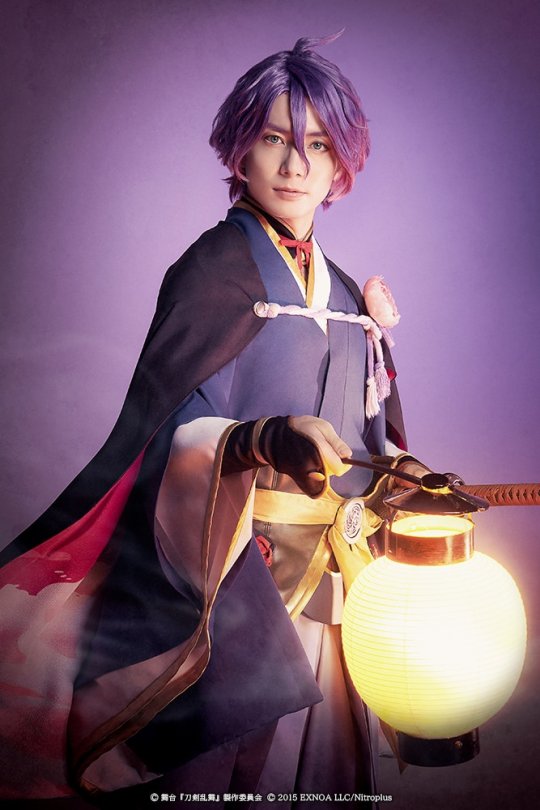

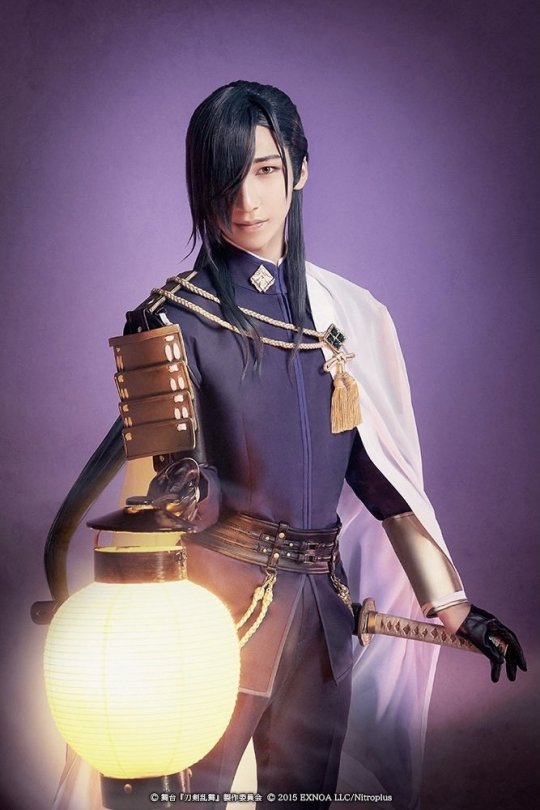
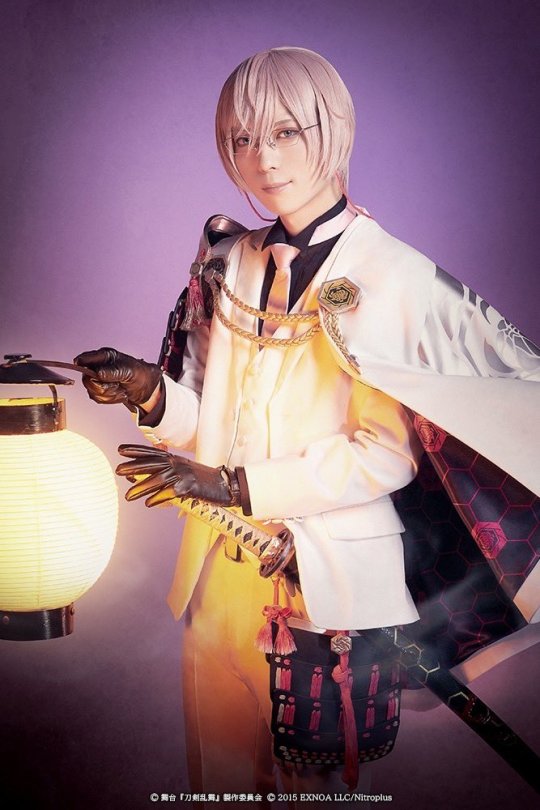

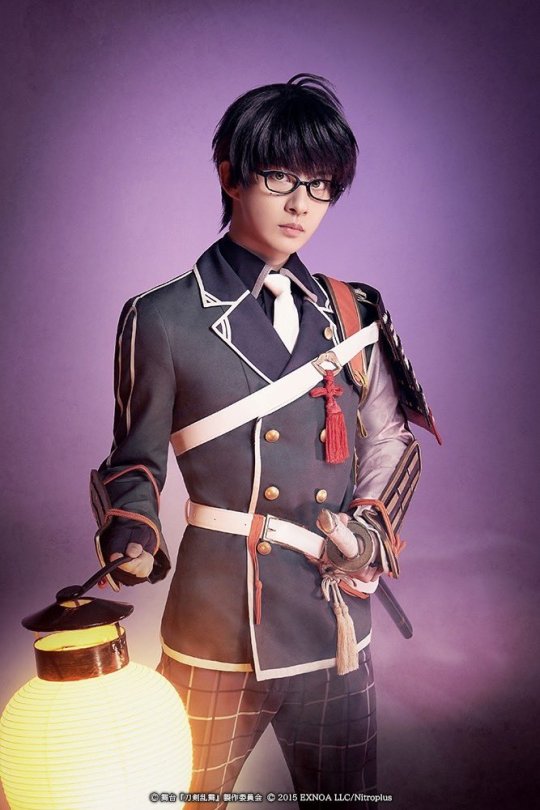
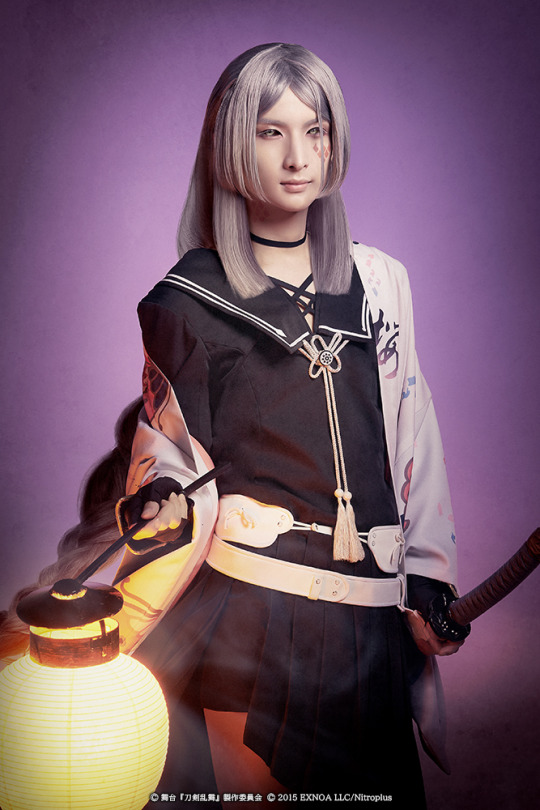
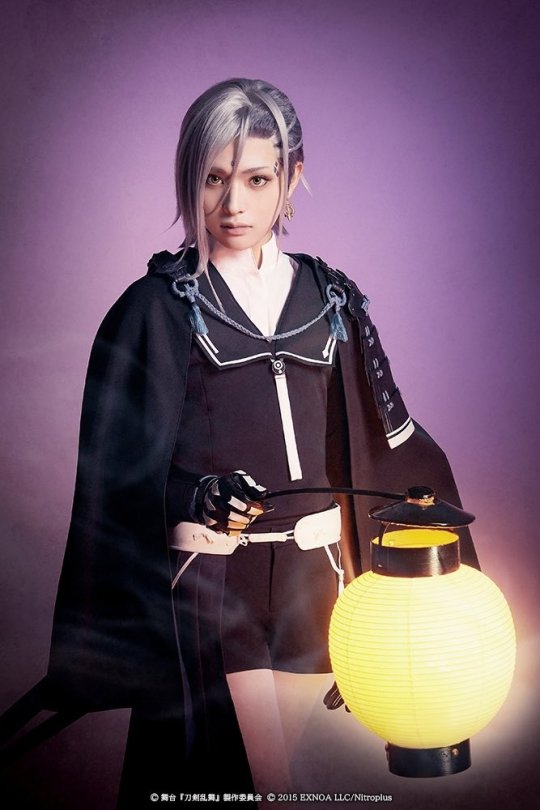

Kiden Ikusa Yu no Adabana NEW VISUALS
Kasen Kanesada- Wada Takuma
Yamanbagiri Chougi- Umetsu Mizuki
Nikkari Aoe- Sano-Mashiro
Kikkou Sadamune- Matsui Yuho
Shishiou- Izaki Ryujiro
Kotegiri Gou- Ohmi Takuto
Kokindenju no tachi- Tsukamoto Ryo
Jizou Yukihira- Hoshimoto Yuzuki
Otomo Sourin- Miura Kouichi
Hosokawa Tadaoki- Saotome Joji
Kuroda Yoshitaka- Yamaura Toru
Dom Justo Takayama- Kurokawa Kyosuke
Konishi Yukinaga- Hotta Masaru
Omura Sumitada- Ishihara Shoichi
Arima Harunobu-Funaki Masahide
Ito Mancio- Matsumura Ryunosuke *
Miguel Chijiwa- Sato Hisanori *
Julian Nakaura- Fukazawa Taiga *
Hara Martino- Yumoto Kenichi *
Hosokawa Gracia- Nanami Hiroki
(*New cast members since Kaihen 2020 production)
46 performances will run:
March 19 ~ April 3, 2021- Meijiza Theater Tokyo
April 22 ~ April 24, 2021- Fukuoka Sun Palace Hotel & Hall
April 30 ~ May 15, 2021 - Osaka Shin-Kabukiza Theater
#butai touken ranbu#Tousute#touken ranbu stage play#Kiden Ikusa Yu no Adabana#Kasen Kanesada#wada takuma#yamanbagiri chougi#umetsu mizuki#nikkari aoe#sano mashiro#kikkou sadamune#matsui yuho#shishiou#izaki ryujiro#kotegiri gou#ohmi takuto#kokindenju no tachi#tsukamoto ryo#jizou yukihira#hoshimoto yuzuki
62 notes
·
View notes
Photo
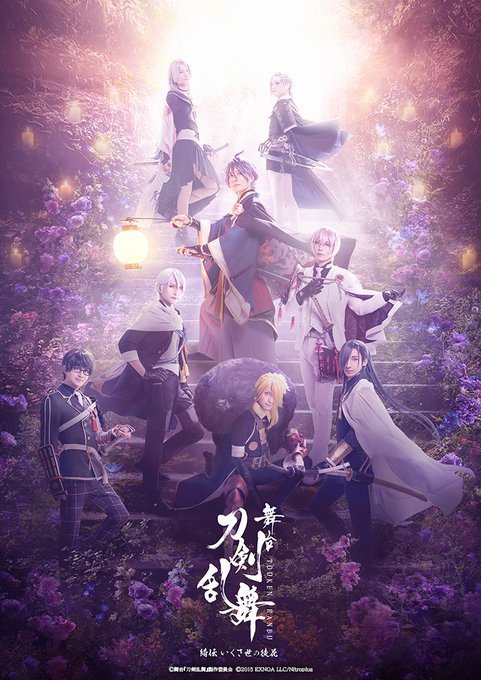
[Pics] 舞台『刀剣乱舞』綺伝 いくさ世の徒花 (butai touken ranbu kiden ikusayu no adabana)
visuals update under the cut^^
Cast:
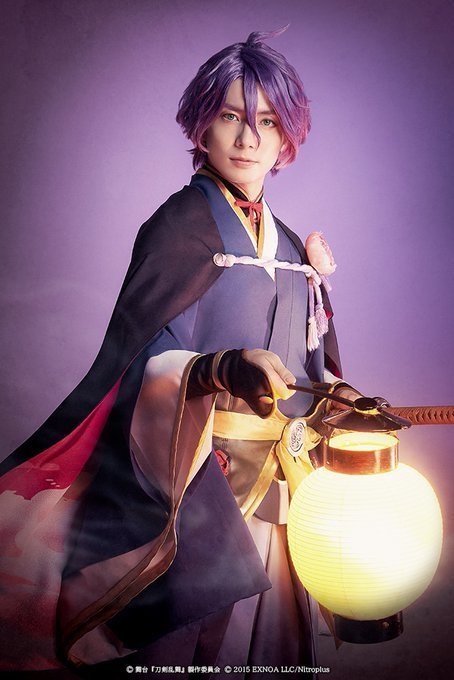
Wada Takuma as Kasen Kanesada (歌仙兼定)
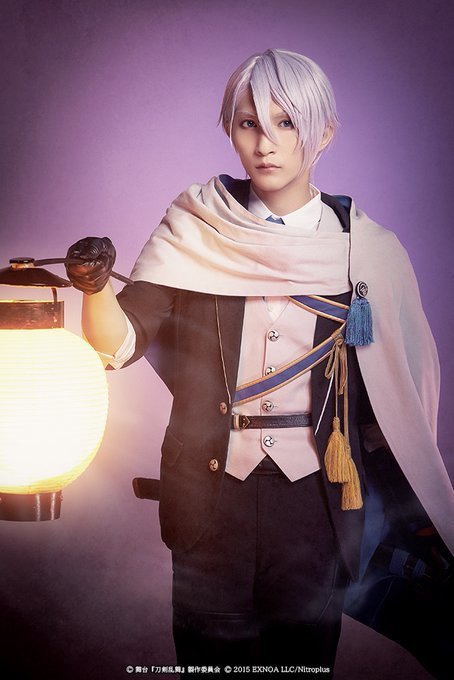
Umetsu Mizuki as Yamanbagiri Chougi (山姥切長義)
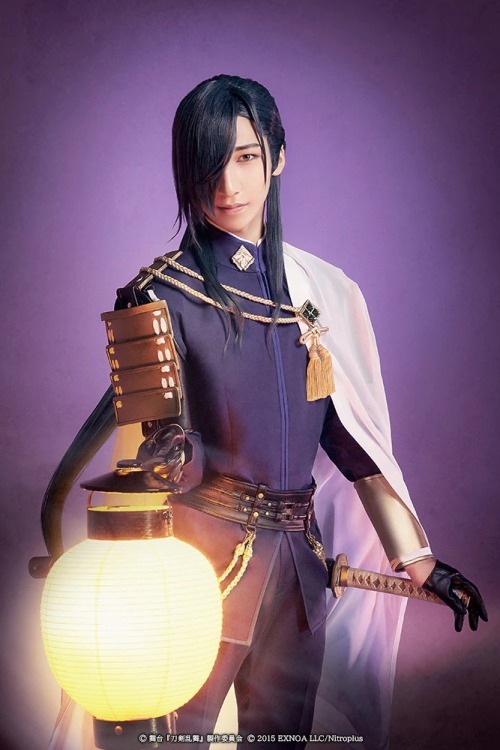
Sano Mashiro as Nikkari Aoe (にっかり青江)

Matsui Yuuho as Kikkou Sadamune (亀甲貞宗)
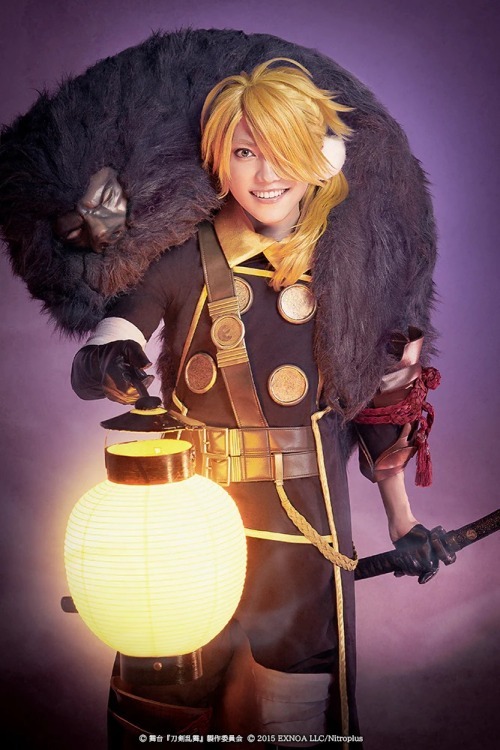
Izaki Ryuujirou as Shishiou (獅子王)

Oomi Takuto as Kotegiri Gou (篭手切江)
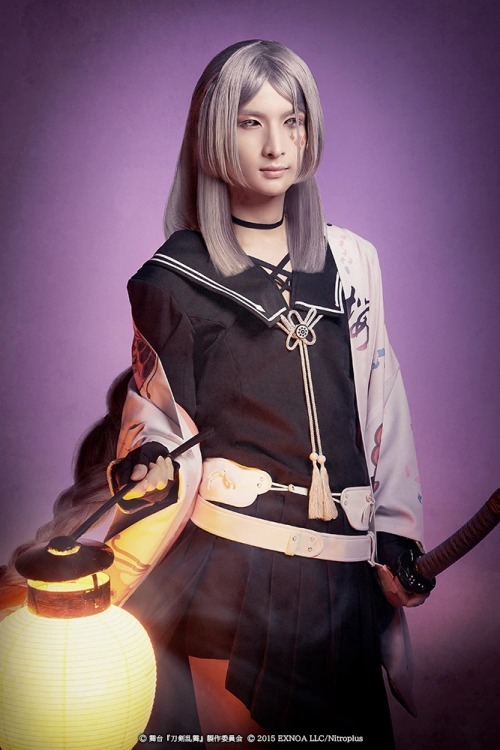
Tsukamoto Ryou as Kokin Denju no Tachi (古今伝授の太刀)

Hoshimoto Yuzuki as Jizou Yukihiro (地蔵行平)
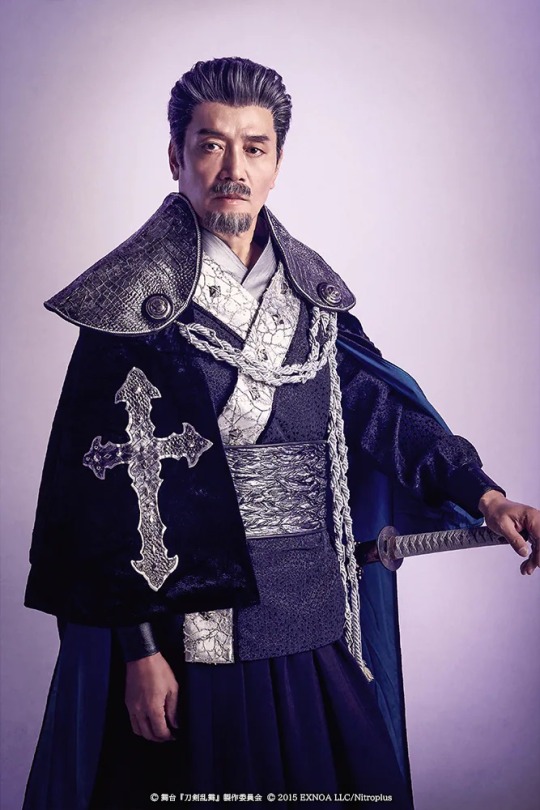
Miura Kouichi as Ootomo Sourin (大友宗麟)

Saotome Jouji as Hosokawa Tadaoki (細川忠興)
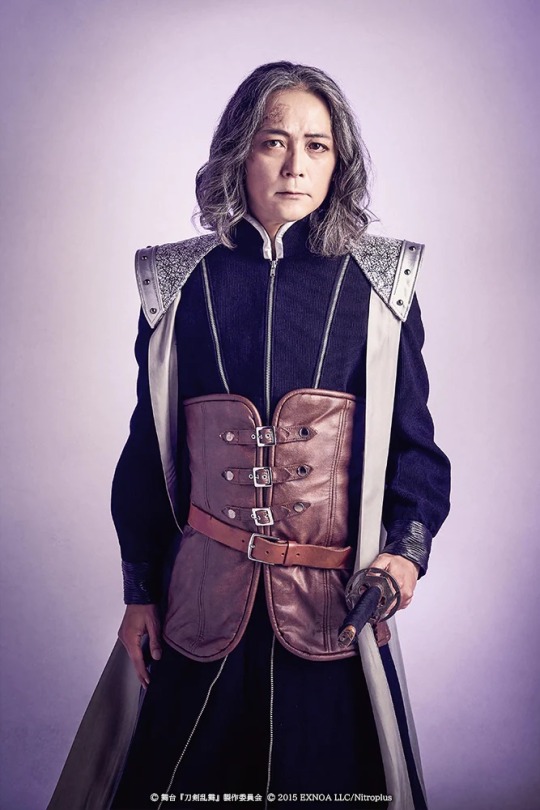
Yamaura Tooru as Kuroda Yoshitaka (黒田孝高)
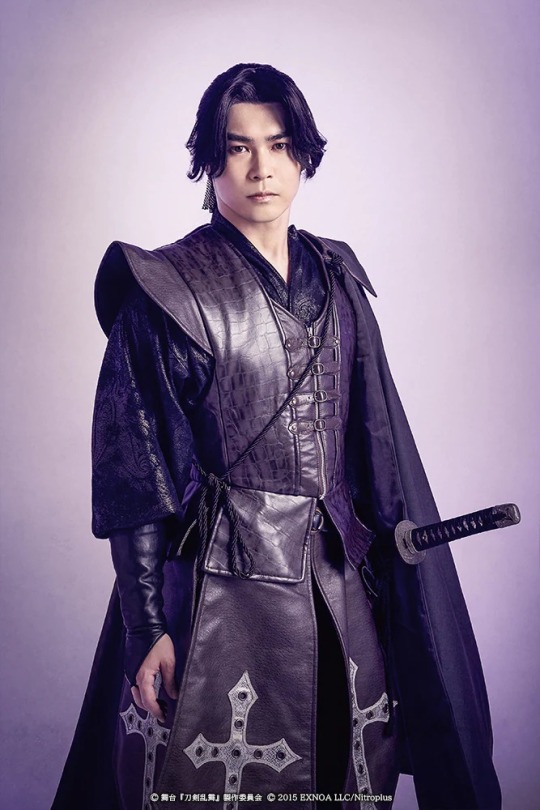
Kurokawa Kyousuke as Takayama Ukon (高山右近)
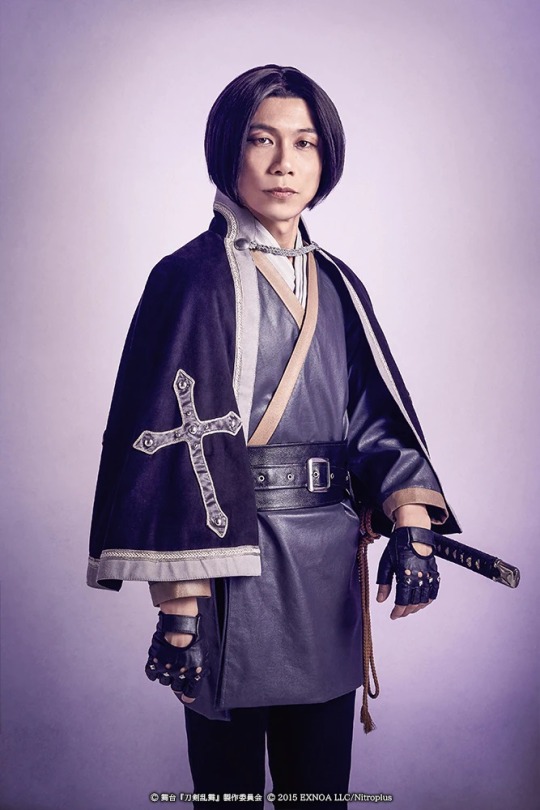
Hotta Masaru as Konishi Yukinaga (小西行長)

Ichihara Shoichi as Oomura Sumitada (大村純忠)

Funaki Masahide as Arima Harunobu (有馬晴信)

Matsumura Ryuunosuke as Itou Mancio (伊東マンショ)
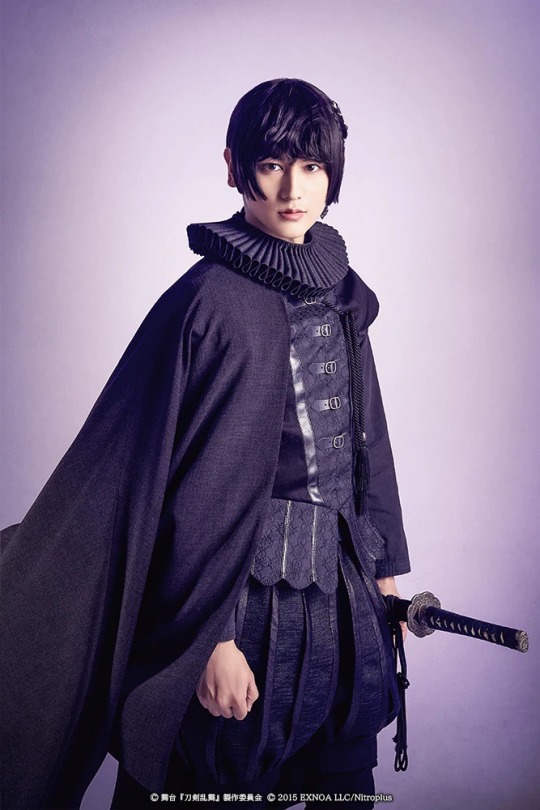
Satou Hisanori as Chijiwa Miguel (千々石ミゲル)
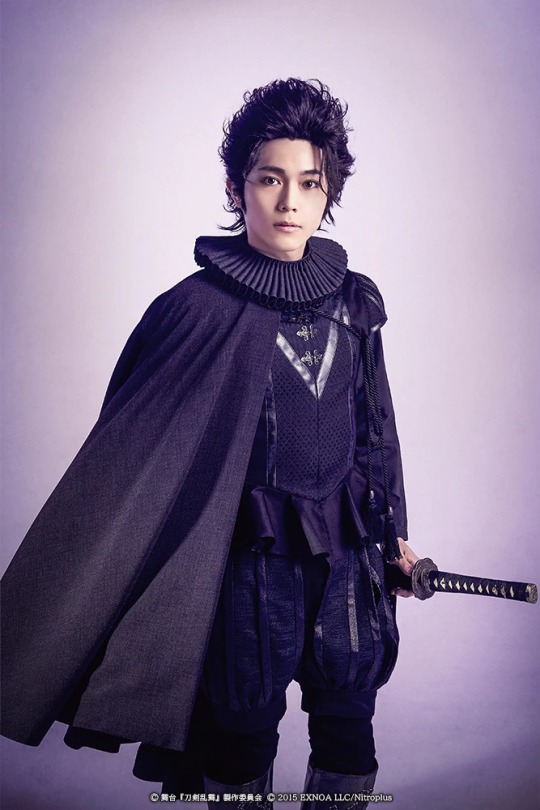
Fukazawa Taiga as Nakaura Giuliano (中浦ジュリアン)

Yumoto Kenichi as Hara Martinão (原マルチノ)
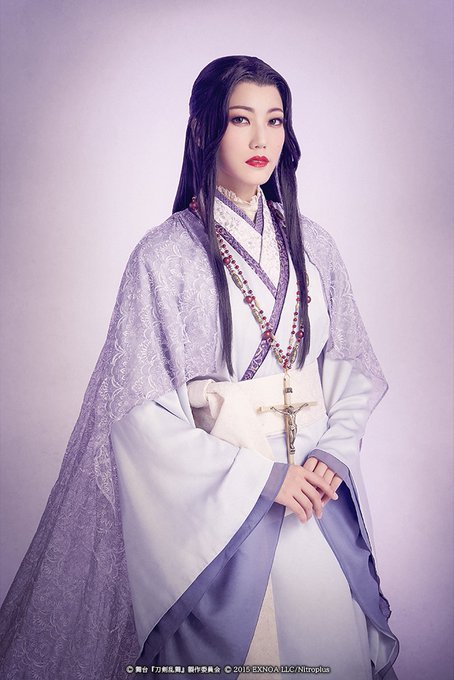
Nanami Hiroki as Hosokawa Gracia (細川ガラシャ)
homepage
twitter
natalie
#舞台 刀剣乱舞#butai touken ranbu#刀剣乱舞#touken ranbu#tousute#和田琢磨#wada takuma#梅津瑞樹#umetsu mizuki#佐野真白#sano mashiro#松井勇歩#matsui yuuho#伊崎龍次郎#izaki ryuujirou#大見拓土#oomi takuto#塚本凌生#tsukamoto ryou#星元裕月#hoshimoto yuzuki#七海ひろき#nanami hiroki#三浦浩一#miura kouichi#早乙女じょうじ#saotome jouji#山浦徹#yamaura tooru#黒川恭佑
25 notes
·
View notes
Text

Ishida Mitsunari, Konishi Yukinaga and Ankokuji Ekei were executed for their "crimes" at the Battle of Sekigahara on this day, November 6, 1600. The captured trio of Ishida Mitsunari, Ankokuji Ekei, and Konishi Yukinaga were publicly exhibited around the Sakai area of Osaka with metal rings placed around their necks and, in Mitsunari’s case, dressed in an embarrassing red and white short-sleeved kimono. In Osaka, Mitsunari was made to shout out his alleged crimes in a loud voice and describe the troubles he had caused as a further embarrassment. The three of them were further exposed to public ridicule in Kyoto. The very next day, November 6, they were executed at Rokujo-ga-hara, the dry riverbed of the Kamo River in Kyoto. Their heads were then put on display beside the city’s Sanjo Bridge. A well-known story is that on his way to the execution grounds, Mitsunari was offered a persimmon, but refused it on the grounds that it would be bad for his indigestion. Konishi, his partner in death, is said to have remarked that as they were about to be put to death, it was hardly necessary to consider his digestion. Mitsunari replied that, "As one can never tell how things are going to turn out, one must at all times take care of one's health.” Mitsunari's skull was stolen from the riverbank, and was re-discovered in 1907 in Kyoto's Sangen-in temple. Using the skull as a base, Mitsunari’s facial features were recreated by Dr. Nagayasu Shuichi, former Chief of engineering of the Tokyo National Research Institute of Police Sciences at the request of photographer and descendent of Mitsunari, Mr. Ishida Takayuki.It appears he had an elongated head and a pronounced defect in his teeth that caused them to bow outwards. The rest of his skeleton was later studied by Dr. Ishida Tetsuro, (no relation) of the Kansai Idai Medical University.
13 notes
·
View notes
Text
amakusa shirou facts
It’s really hard to find online resources about Amakusa Shirou in English since there’s not a lot of interest besides from Fate fans, but I figured I could translate some stuff from Japanese Wikipedia and add some context from my own knowledge.
‘Amakusa’ isn’t actually his patrilineal surname- he was born Masuda Shirou. ‘Amakusa’ actually comes from the place he was born, the Amakusa Islands, which are very close to the Shimabara Peninsula in the very southern-most part of Japan, Kyushu. At first it confused me how ‘Tokisada’ fit into his name in the English version, but it’s actually a Japanese post-humous name, not anything like a middle name. His baptismal name was Geronimo first, though he later changed it to Francisco.
His father was Masuda Yoshitsugu (益田好次), who had worked as a secretary for the daimyo Konishi Yukinaga. I can’t find his mother’s birth name, but she was baptized as Martha and was a younger sister of Senzoku Zen’enmon (千束善右衛門), one of the rounin who later guided Shirou in the Shimabara Rebellion. He had two older sisters and one younger sister.
The Shimabara Rebellion was the final straw that caused sakoku (’closed country’, the closing of Japan to westerners), but the greater forces surrounding it had been brewing for decades. Though European imperialism in Asia is often more associated with events that happened later, in the 1700s and 1800s, it had already started by the 1600s. The Portuguese conquered the sultanate of Malacca in Malaysia in 1511, hoping to use it to export spices to Europe. In the Castilian War in Brunei in 1578, the Spanish attempted to forcibly convert the Muslim local population to Catholicism, though at the time it ended in a stalemate. As well, the Portuguese also antagonized China by conducting piracy and stealing children to sell as slaves in Malacca, or further abroad, leading to the Battle of Shancaowan in 1522. Much later, this would lead to events like the Opium Wars in the 1840s-1860s, where Britain and France warred against China to force the Chinese government to continue allowing the sale of the drug opium (the same active ingredient in modern heroin).
Japan would remain closed to the west until 1853, when American warships entered the mouth of Edo Bay and Admiral Perry refused to go to the designated port in Nagasaki instead to deliver his message from the president. In his journal he wrote that the refusal was intentional, “To show these princes how little I regarded their order for me to depart, on getting on board I immediately ordered the whole squadron underway, not to leave the bay… but to go higher up… would produce a decided influence upon the pride and conceit of the gov’t, and cause a more favorable consideration of the President’s letter." In February the next year, Perry returned with more warships and refused to leave until a treaty favorable to the Americans was signed. That treaty is now called the Convention of Kanagawa.
21 notes
·
View notes
Text
Like Fathers Like Sons
I imagine most people subscribed to this tumblr are familiar with the famous strategists Takenaka “Hanbei” Shigeharu and Kuroda “Kanbei” Yoshitaka. They served Oda Nobunaga and Toyotomi Hideyoshi during their come ups and are considered two of the most brilliant strategists of the Sengoku Jidai.
Now, Kanbei ended up having a pretty famous son named Kuroda Nagamasa. He fought in Korea, fought at Sekigahara and Osaka, and is most famous (or infamous depending on your fandom) for having slain Shima Sakon! Hanbei’s son, however, is not as famous. His name was Takenaka Shigekado. But today we are bringing a bit more fame to this unloved boy with a tale from Sekigahara!
Much like how Hanbei and Kanbei worked together did you know that Shigekado and Nagamasa worked together as well? Though, they did not fight for the Toyotomi! At Sekigahara the Takenaka and Kuroda clans both sided with the Tokugawa. It is theorized that Kanbei could see the tides of the time and may have been behind this switching of loyalties.
At the battle of Sekigahara they actually camped together and worked together in the take down of Shima Sakon! Also of note, Nagamasa wasn’t the only one to take a famous head at Sekigahara. Hanbei’s son Shigekado would be the one to slay Konishi Yukinaga! For their efforts and kills both boys ended up being praised by Tokugawa Ieyasu and getting pretty nice plots of land.
It is said that like Kanbei, Nagamasa was said to be quite smart and a good general. It is also said that like Hanbei, Shigekado was quite intelligent and ended up being well versed in poetry and calligraphy!
#takenaka#kuroda#naga kuroda#takenaka hanbei#takenaka shigeharu#kuroda kanbei#hanbei shigekado#samurai#samurai warriors#sengoku#sengoku jidai#sengoku era#samurai fun facts#samurai facts#facts
13 notes
·
View notes
Text
Subjugation of Uesugi and Mitsunari’s coup d’état as seen by Jesuits in Japan
This is a record of political situation in Japan from March(?) to July of 1600 as seen by Jesuits.
Jesuits records are known for being very in favour of Christian daimyō (and apparently their bffs too).
If you’re a fan of Mitsunari-Kagekatsu’s secret pact, you’ll be happy.
If you thought that Western army was doomed from the beginning, this tells a different story.
Should you take this at face value? Probably not.
This was translated from Latin to Japanese to English.
Some parts are translated freely. English is not my native language. Nor is Japanese.
I would also appreciate if you didn’t repost this anywhere.
At this time all lords have already returned to the capital, but there were some exceptions. They were Hizen-dono (Maeda Toshinaga), who was still staying in his own fief✶1, and the other one was (Uesugi) Kagekatsu✶2, another feudal lord. Kagekatsu was one of the senior magistrates✶3 (tairō) and one of the most powerful lords in Japan and his territory was next to Naifu-sama’s (Tokugawa Ieyasu) one. Kagekatsu used an excuse that Taikō-sama (Toyotomi Hideyoshi) allowed him to stay in his territory for three years and refused to return to the capital. This feudal lord was a very close friend of Jibu no shō (Ishida Mitsunari) and was on bad terms with Naifu-sama, so that’s why Naifu-sama found his decision extremely unsatisfactory. He sent Kagekatsu a letter: “If you don’t immediately come to the capital, I will lead an army myself and punish you as a rebel.”
However Kagekatsu, together with Jibu no shō, Hizen-dono (Maeda Toshinaga) and other lords, who didn’t like Naifu-sama, formed a secret alliance (and it was a very clever ploy). As a strategy, Kagekatsu provoked Naifu-sama with a letter ✶4, so Naifu-sama had no choice, but be forced to go to subjugate Kagekatsu. (...) Naifu-sama went in a hurry as he thought that everyone would follow him immediately and went with confidence with all his troops to Kantō. Some of the bugyō followed Naifu-sama, but their progress was slow. One of them passed through Jibu no shō’s castle, got in touch with him and they decided to make the plan they worked on for some time public.✶5 There they discussed things with those who came later and everyone returned to Ōsaka and acted immediately. With this the relationship between the two✶6 broke down and almost all lords of Japan formed an alliance that went against Naifu-sama.
Chief bugyō as well as the three bugyō in Ōsaka joined with them✶7, they teamed up and revealed the hostile position against Naifu-sama and expelled him from politics. They sent Naifu-sama a message advising him to stay in his own fief and charged him with offense against the young lord Hideyori-sama and his father Taikō-sama’s orders.✶8
Among those who participated in this alliance, the important people were Dom Agostinho (Konishi Yukinaga) and his best friend Jibu no shō (Ishida Mitsunari). Both were very courageous and intelligent and felt great obligation to Taikō-sama. When Taikō-sama was alive, he held deep affection for both of them and it was also thanks to him that they became feudal lords. Therefore, both of them couldn’t stand that the son of Taikō-sama could be stripped of what was rightfully his and that he would suffer damage in terms of honour and status. So both of them always worked as loyal subject of the young lord, so he could keep his status. And their colluding with other lords ultimately brought this alliance. No matter if it was successful or not, there was never anything as elaborated as this alliance in Japanese political history. Thanks to this, great fame an honour was attributed to these two lords.
✶1 After the subjugation of Kaga.
✶2 the Jesuits just call Kagekatsu Kagekatsu. They used to call Ieyasu just Ieyasu as well, but now he’s “Naifu-sama” (actually at that time it was read as “Daifu-sama”). It is assumed that Jesuits were using names they heard most often, so it is assumed that Uesugi Kagekatsu was actually referred to as just Kagekatsu. In some letters written by other daimyō he’s also talked about as “Kagekatsu”. Or they misunderstood and thought it was his surname.
✶3 nowadays we say go-bugyō and go-tairō, but it seems that at the beginning it was just ten bugyō - in Jesuits records they sometimes use senior and junior bugyō
✶4 Naoe-jō???
✶5 If this sounds familiar, it’s because it most likely talks about Yoshitsugu.
✶6 Kagekatsu and Ieyasu??? Mitsunari and Ieyasu???
✶7 Chief bugyō - Terumoto, Ukita Hideie
three bugyō in Ōsaka - Mashita, Natsuka, Maeda Gen’i
“them” - Mitsunari, Yoshitsugu, Ankokuji Ekei, Yukinaga?
✶8 by writing the letter “what did Ieyasu do wrong”
Translated from an excerpt published in 『十六・七世紀イエズス会日本報告集』における関ヶ 原の戦い関連の記載についての考察(その1) ―関ヶ原の戦いに至る政治状況と関ヶ原の戦い当日の実戦の状況― by 白峰旬
2 notes
·
View notes
Text
Someone suggested an Assassin's Creed game about the Japanese-Korean wars of 1590s and to make a major antagonist out of Konishi Yukinaga and something primal awoke within me this is my thing
5 notes
·
View notes
Photo






“Shimabara” - Shimabara no ran 島原の乱 - rébellion de Shimabara
Yamamoto Takato 山本タカト (1960 - ).
Source :
http://seerpic.pw/Takato-Yamamoto-art-i-enjoy-t-Yamamoto.html
Note : Importante révolte de paysans au cours du Shōgunat Tokugawa en 1637–1638 qui eut lieu dans la presqu’île de Shimabara 島原 et les îles Amakusa-shotō 天草諸島, situées à Kyūshū 九州, à soixante-dix kilomètres de Nagasaki-shi 長崎市.
Les causes du soulèvement furent loin d'être exclusivement religieuses, mais les paysans insurgés et leur chef Amakusa Shirō 天草四郎 (de son vrai nom Masuda Tokisada 益田時貞 (1621?-1638), étaient généralement portés par la foi chrétienne.
Les missions jésuites implantées depuis plus d'un siècle rencontraient de grands succès dans ces régions pauvres, à tel point que deux daimyō 大名 locaux, Arima Harunobu 有馬晴信 (1567-1612) rebaptisé kirishitan et Konishi Yukinaga 小西行長 (1555-1600) rebaptisé Agostinho, furent convertis.
Le shōgun 将軍 Tokugawa Iemitsu 徳川家光 (1604-1651) voit d'un très mauvais œil la montée du christianisme et fait expulser les missionnaires jésuites puis attaque les rebelles chrétiens de Shimabara retranchés dans le château de Hara-jō 原城. Shirō mène la défense du château de Hara et meurt lorsque celui-ci est pris le 12 avril 1638. Il a alors 17 ans. Sa tête est exposée sur une pique à Nagasaki pendant une longue période comme avertissement pour d'éventuels autres rebelles chrétiens.
Dates : 11 décembre 1637 - 12 avril 1638
Lieu : Hara-jō 原城
Issue : Bakufu-gun no shōri 幕府軍の勝利 - Victoire militaire du Tokugawa bakufu 徳川幕府 (1603 à 1867)
#yamamoto takato#takato yamamoto#painter#designer#illustrator#painting#japan#peintre#peinture#dessinateur#illustrateur#illustration#japon#shimabara no ran#tokugawa iemitsu
240 notes
·
View notes